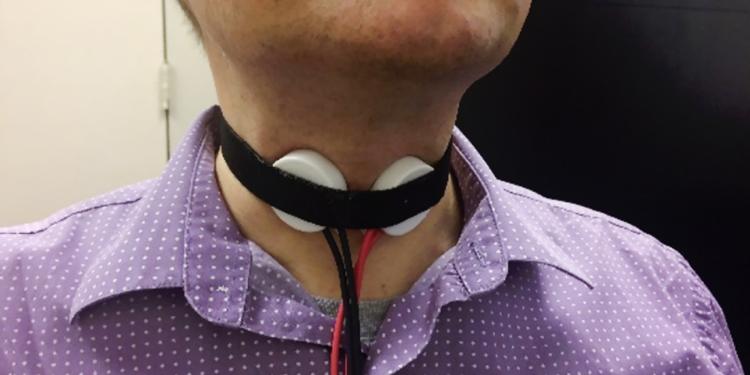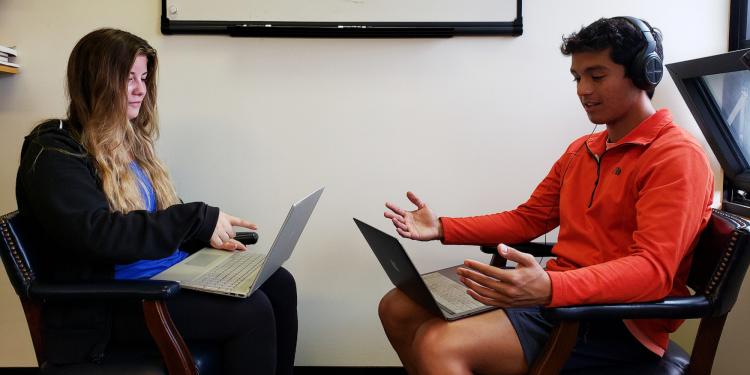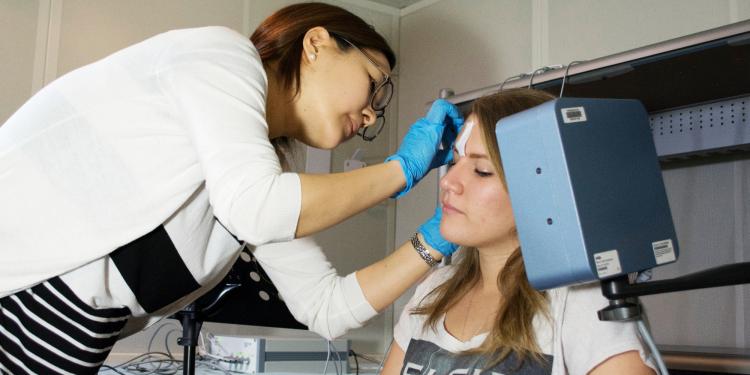The Speech Core: Research in Speech Production and Perception
Enhancing the understanding of speech science
The faculty comprising the Speech Core within the Department of Communication Sciences and Disorders take a comprehensive look at speech perception and production.
Areas of research include stuttering, phonological disorders, dysarthria, motor speech, somatosensation, speech acoustics, bilingualism, and collaborative language use.

Collaborative Language Use Lab
Principal Investigator: Annie Olmstead, Ph.D.
Studying Perceptual Learning for Speech, Collaborative Language Use, Speech Perception, Speech Production
This lab conducts behavioral research examining the influence of social context on speech and language use and learning in adults. Specifically, we focus on communication between individuals communicating with partners from different language or dialect backgrounds and partners with speech impairments.
Through this work, we are examining how specific social/communicative imperatives drive flexibility in speech production and perception. One aspect of flexibility that we focus on is perceptual learning for speech.

Experimental Phonetics Laboratory
Principal Investigator: Michael Robb, Ph.D., CCC-SLP (retired)
Studying Stuttering, Early Vocal Development, Phonological Disorders
This lab focuses on acoustic, physiological, and phonetic features of normal and disordered speech production across the lifespan. We are engaged in international collaborations with researchers in Germany, New Zealand, Australia, Japan, Hong Kong, and Kuwait.
Past and current research projects include (1) the influence of bilingualism and diglossia on normal and disfluent speech production, (2) the interaction of age and stuttering type on speech efficiency, (3) describing laryngeal-based phenomena in early vocal development among healthy and at-risk infants and (4) transgender voice and communication. Lab instrumentation includes acoustic analysis software, fNIRS system, acoustic pharyngometer, electromyographic and electrodermal analysis systems, and an electroglottograph.

Speech, Language, and Cognition Lab
Principal Investigator: Navin Viswanathan, Ph.D.
Visit the lab website | Twitter
Studying Speech Perception, Speech Production, Bilingualism, Ecological Approaches to Studying Spoken Language Processes
In this lab, we study the social and cognitive factors that shape spoken language use. The overarching question that we seek to answer is how human interlocutors (listeners and speakers) demonstrate robust spoken communication despite a highly variable speech signal (due to different speakers, dialects, listening environments etc.). In particular, we are interested in studying this under conditions that are ecologically typical to ensure that the theories we develop and the interventions we design translate outside the lab.
We study monolingual, bilingual, healthy, and those with communication disorders to improve our understanding of spoken language processes and inform interventions. We frequently collaborate with the Collaborative Language Use lab (Dr. Olmstead) and the Speech Production Lab (Dr. Lee) in this enterprise. In addition, we also work with several researchers at the Center for Language Science to tackle a broad range of related questions (e.g., those of second language learning, codeswitching between languages etc.).

Speech Production Laboratory
Principal Investigator: Jimin Lee, Ph.D., CCC-SLP
Studying Dysarthria, Articulatory Kinematics, Speech Acoustics, Speech Intelligibility
This lab seeks to understand why less comprehensible speech occurs by examining speech sound, tongue movement, and intelligibility. The long-term goal of the laboratory is to develop strategies to enhance speech intelligibility of individuals with dysarthria. In addition, in collaboration with Dr. Olmstead and Dr. Viswanathan, we investigate how speech production and perception change in interactive contexts between people with dysarthria and their caregivers.
Research in this laboratory focuses on articulatory kinematics (with an emphasis on tongue and jaw movement), speech acoustics, and speech intelligibility in speakers with and without dysarthria. The Speech Production Laboratory is equipped with a portable 3-dimensional electromagnetic articulography, or EMA (Wave system, Northern Digital Inc.). In addition, Speech Core is newly equipped with AG501 (Carstens Medizinelektronik GmbH), a type of EMA. The EMA systems allow examining tongue movement with synchronized acoustic signals in a non-invasive and safe way.



